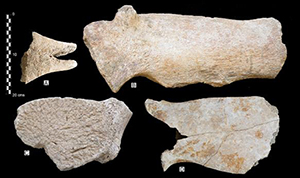Crossref Citations
This article has been cited by the following publications. This list is generated based on data provided by
Crossref.
Rodrigues, Ana S.L.
Horwitz, Liora Kolska
Monsarrat, Sophie
and
Charpentier, Anne
2016.
Ancient whale exploitation in the Mediterranean: species matters.
Antiquity,
Vol. 90,
Issue. 352,
p.
928.
Bernal-Casasola, D.
Expósito, J. A.
and
Díaz, J. J.
2018.
The Baelo Claudia Paradigm: The Exploitation of Marine Resources in Roman Cetariae.
Journal of Maritime Archaeology,
Vol. 13,
Issue. 3,
p.
329.
Lowe, Benedict
2018.
Manilius and the Logistics of Salting in the Roman World.
Journal of Maritime Archaeology,
Vol. 13,
Issue. 3,
p.
467.
Rodrigues, Ana S. L.
Charpentier, Anne
Bernal-Casasola, Darío
Gardeisen, Armelle
Nores, Carlos
Pis Millán, José Antonio
McGrath, Krista
and
Speller, Camilla F.
2018.
Forgotten Mediterranean calving grounds of grey and North Atlantic right whales: evidence from Roman archaeological records.
Proceedings of the Royal Society B: Biological Sciences,
Vol. 285,
Issue. 1882,
p.
20180961.
Pétillon, Jean-Marc
Chauvière, François-Xavier
Speller, Camilla
McGrath, Krista
Rodrigues, Ana S.L.
Charpentier, Anne
and
Baleux, François
2019.
A Gray Whale in Magdalenian Perigord. Species identification of a bone projectile point from La Madeleine (Dordogne, France) using collagen fingerprinting.
Paléo,
p.
230.
Mazzoldi, Carlotta
Bearzi, Giovanni
Brito, Cristina
Carvalho, Inês
Desiderà, Elena
Endrizzi, Lara
Freitas, Luis
Giacomello, Eva
Giovos, Ioannis
Guidetti, Paolo
Ressurreição, Adriana
Tull, Malcolm
MacDiarmid, Alison
and
Bianchi, Carlo Nike
2019.
From sea monsters to charismatic megafauna: Changes in perception and use of large marine animals.
PLOS ONE,
Vol. 14,
Issue. 12,
p.
e0226810.
Thongcharoenchaikit, Cholawit
and
Eda, Masaki
2020.
Discriminant function analysis of atlas and axis vertebrae of the toothed whale to facilitate species identification in zooarchaeological specimens.
International Journal of Osteoarchaeology,
Vol. 30,
Issue. 6,
p.
843.
Perissi, Ilaria
and
Bardi, Ugo
2021.
The Empty Sea.
p.
41.
Cabrera, Andrea A.
Bérubé, Martine
Lopes, Xênia M.
Louis, Marie
Oosting, Tom
Rey-Iglesia, Alba
Rivera-León, Vania E.
Székely, Dóra
Lorenzen, Eline D.
and
Palsbøll, Per J.
2021.
A Genetic Perspective on Cetacean Evolution.
Annual Review of Ecology, Evolution, and Systematics,
Vol. 52,
Issue. 1,
p.
131.
Charpentier, Anne
Rodrigues, Ana S.L.
Houmard, Claire
Lefebvre, Alexandre
McGrath, Krista
Speller, Camilla
van der Sluis, Laura
Zazzo, Antoine
and
Pétillon, Jean-Marc
2022.
What's in a whale bone? Combining new analytical methods, ecology and history to shed light on ancient human-whale interactions.
Quaternary Science Reviews,
Vol. 284,
Issue. ,
p.
107470.
Aiken, Magie
Gladilina, Elena
Çakırlar, Canan
Telizhenko, Serhii
van den Hurk, Youri
Bejenaru, Luminita
Tange Olsen, Morten
and
Gol'din, Pavel
2023.
Prehistoric and historic exploitation of marine mammals in the Black Sea.
Quaternary Science Reviews,
Vol. 314,
Issue. ,
p.
108210.
Buss, Danielle L.
van den Hurk, Youri
Falahati-Anbaran, Mohsen
Elliott, Deirdre
Evans, Sally
Frasier, Brenna A.
Mulville, Jacqueline A.
Rankin, Lisa K.
Stebergløkken, Heidrun
Whitridge, Peter
Barrett, James H.
and
Hart, John P.
2023.
Archaeological evidence of resource utilisation of the great whales over the past two millennia: A systematic review protocol.
PLOS ONE,
Vol. 18,
Issue. 12,
p.
e0295604.
Agiadi, Konstantina
Caswell, Bryony A
Almeida, Rita
Becheker, Ali
Blanco, Andreu
Brito, Cristina
León-Cobo, Manuel Jesús
Cook, Ellie-Mae E
Costantini, Federica
Karakuş, Merve
Leprieur, Fabien
López, Cataixa
López-López, Lucía
O’Dea, Aaron
Pallacks, Sven
Rabanal, Irene
Schultz, Lotta
Tanner, Susanne E
Theodoropoulou, Tatiana
Thurstan, Ruth H
Vieira, Nina
Darnaude, Audrey M
and
Selden, Rebecca
2024.
Geohistorical insights into marine functional connectivity.
ICES Journal of Marine Science,
Vol. 81,
Issue. 10,
p.
1884.
Nabais, Mariana
Soares, Rui
Hurk, Youri van den
and
Meloro, Carlo
2024.
The Zooarchaeology of ancient whaling practices in Portugal: A review and a new Roman Republican contribution at Castelo Velho de Safara.
PLOS ONE,
Vol. 19,
Issue. 11,
p.
e0310215.
